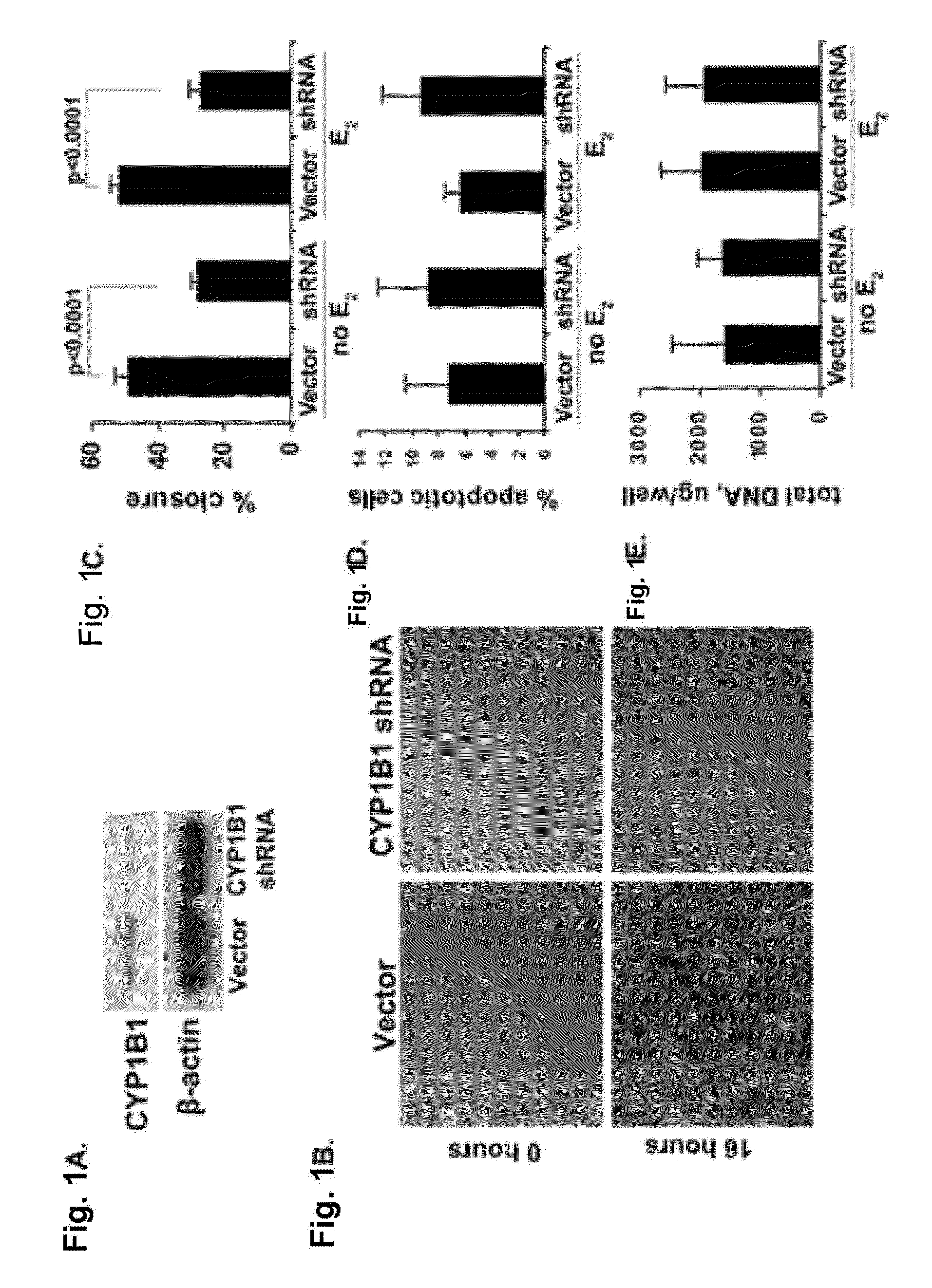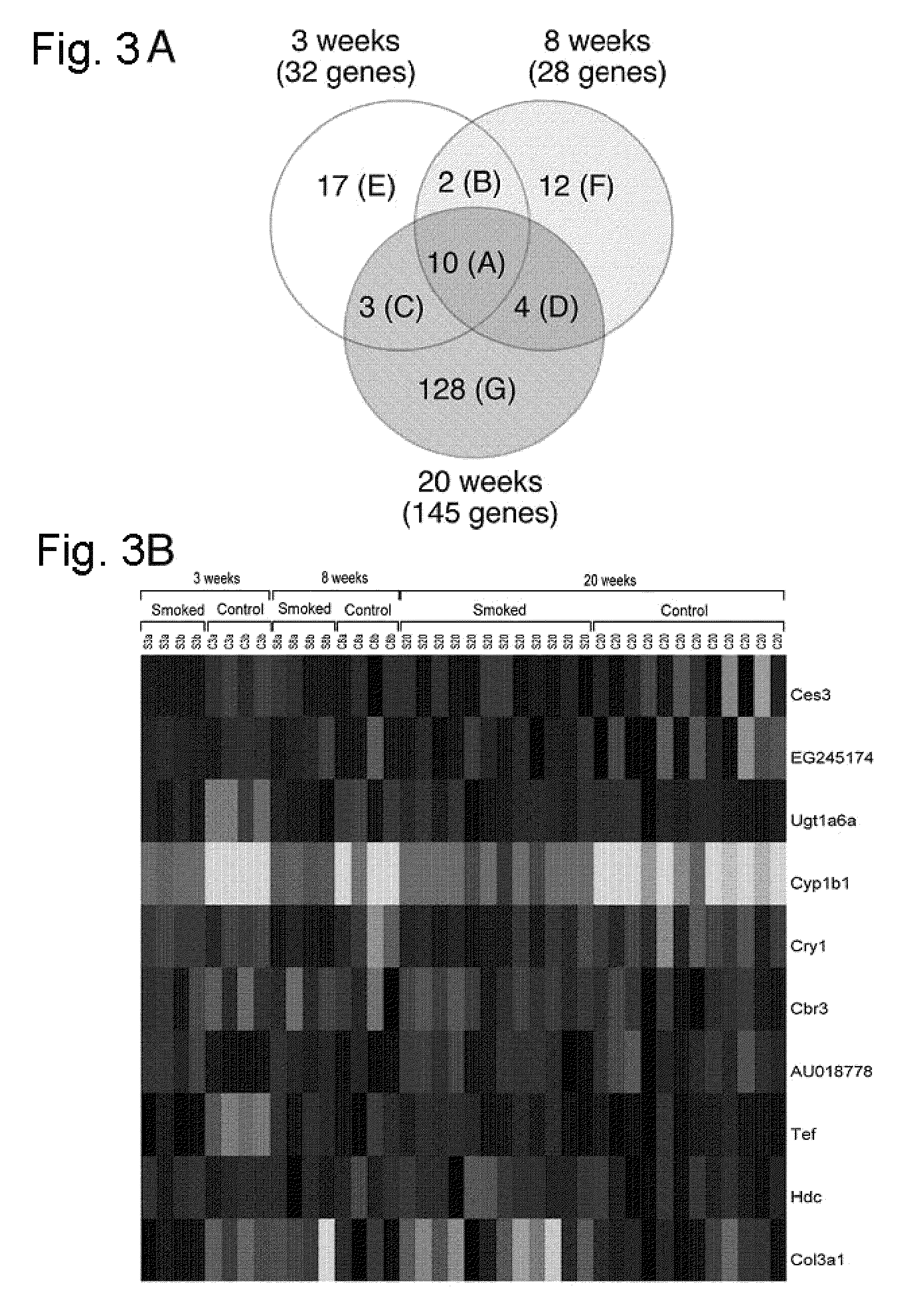Targeting of CYP1B1 in the treatment of head and neck cancer and lung cancer
a technology of cyp1b1 and lung cancer, applied in the field of cancer treatment, can solve the problems of major risk factors for developing lung cancer or hnscc, and achieve the effects of suppressing cyp1b1 mrna, inhibiting motility or proliferation, and inhibiting the expression of cyp1b1 gen
- Summary
- Abstract
- Description
- Claims
- Application Information
AI Technical Summary
Benefits of technology
Problems solved by technology
Method used
Image
Examples
example 1
Knockdown of CYP1B1 Expression
Materials and Methods.
[0073]Cell lines and treatments. MSK-Leuk1 cells were derived from a dysplastic leukoplakia lesion located adjacent to a SCC of the tongue. MSK-Leuk1 cells were cultured in KGM medium (Lonza, Walkersville, Md.). MSK-Leuk1 cells (passage 33) were determined to be identical to the early passage MSK-Leuk1 cells (Identity Mapping Kit, Coriell Institute for Medical Research, Camden, N.J.). All HNSCC cell lines were derived from patients with SCC of the tongue. SCC9 (male) and SCC15 (male) cells were cultured in S-MEM medium, supplemented with 2 mM L-glutamine, 100 units / ml penicillin, 100 μg / ml streptomycin and 10% FBS. UPCI:SCC56 (male), UPCI:SCC103 (female) and UPCI:SCC122 (male) cells were cultured in MEM medium, supplemented with 2 mM L-glutamine, 100 μM non-essential amino acids, 50 μg / ml gentamycin (Gibco) and 10% FBS.
[0074]For all the experiments that involved estradiol (E2) exposure, MSK-Leuk1 cells were cultured in phenol red-f...
example 2
Tobacco Smoke Modulation of Gene Expression in Lung Tissue
Materials and Methods.
[0084]Tobacco smoke exposure. Female A / J mice, 8 to 9 weeks of age, were purchased from The Jackson Laboratory and maintained with free access to food (AIN-93G, Harlan Teklad Global Diets) and water. Body weights were recorded weekly to monitor growth. All procedures were approved by the Institutional Animal Care and Use Committee of the University of Kentucky.
[0085]Mice were randomized into six treatment groups (six per group) and exposed to either tobacco smoke or HEPA-filtered ambient air (control). Exposure of mice to sidestream smoke was carried out in whole-body chambers for 6 hours per day, 5 days per week for 3, 8, and 20 weeks. Sidestream smoke was generated from the University of Kentucky reference cigarette (2R4F), and the suspended smoke particulate concentration in the chamber atmosphere was maintained at approximately 40 to 45 mg / m3.
[0086]Exposure of mice to smoke was ascertained by measuri...
example 3
Selective Inhibition of CYP1B1
[0115]The goal of these experiments was to evaluate the effect of chemical inhibition of CYP1B1 on the motility of head and neck cells. Homoeriodictyol, a known naturally occurring flavonoid and a selective inhibitor of CYP1B1 (Doostdar H. et al., (2000) Toxicology 144:31-38) was used in this study.
[0116]Cell motility assay. MSK-Leuk1 cells were incubated with either vehicle (ethanol, final concentration 0.01% in the medium) or homoeriodictyol at concentrations of 5 and 10 μg / ml for 5 days and the medium with either vehicle or homoeriodictyol was every other day. At the end of the fifth day, the cells were plated at 100% confluence in the medium containing either vehicle or homoeriodictyol. Twenty-four hours later the surface of the cell culture dish was carefully scratched using a micropipette tip, thus making an evenly distributed gap in the cell monolayer. The cells were washed with PBS and fresh medium (containing either vehicle or homoeriodictyol) ...
PUM
| Property | Measurement | Unit |
|---|---|---|
| emission wavelength | aaaaa | aaaaa |
| excitation wavelength | aaaaa | aaaaa |
| concentration | aaaaa | aaaaa |
Abstract
Description
Claims
Application Information
 Login to View More
Login to View More - R&D
- Intellectual Property
- Life Sciences
- Materials
- Tech Scout
- Unparalleled Data Quality
- Higher Quality Content
- 60% Fewer Hallucinations
Browse by: Latest US Patents, China's latest patents, Technical Efficacy Thesaurus, Application Domain, Technology Topic, Popular Technical Reports.
© 2025 PatSnap. All rights reserved.Legal|Privacy policy|Modern Slavery Act Transparency Statement|Sitemap|About US| Contact US: help@patsnap.com



